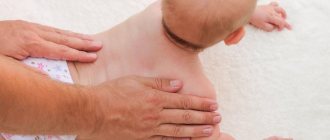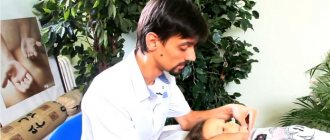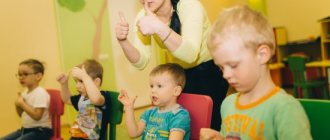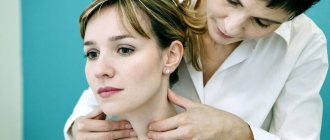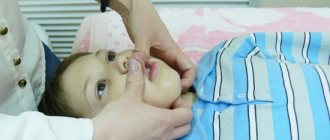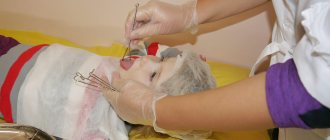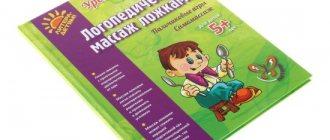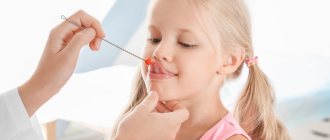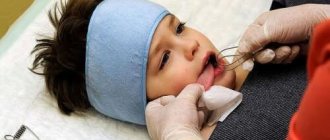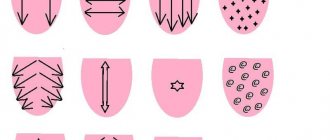Massage of the upper lip after uranoplasty
- carried out in the postoperative period after removal of sutures;
- is the main method of preventing the occurrence of scars on the upper lip;
- promotes the development of articulatory function of the lip.
Massage includes:
· longitudinal stroking
(with the index fingers of both hands, movements are made from the base of the nose to the sides towards the corners of the mouth) – 10 seconds.
· cross stroking
(with the index fingers of both hands, movements are made from the base of the nose to the red border of the upper lip, perpendicular to the line of the mouth, down and up) – 10 seconds.
· straight rubbing
(the index fingers of both hands are moved from the base of the nose down to the edge of the upper lip and to the sides towards the nasolabial folds and back) - 20-30 seconds.
· circular and spiral rubbing
(the index fingers of both hands make circular and spiral movements at the base of the nose and upper lip) – 10 seconds.
· rubbing by sawing
(using the index fingers of both hands, “sawing” movements are made in the transverse and longitudinal directions from the base of the nose down to the edge of the upper lip and to the sides towards the nasolabial folds) – 10-20 seconds.
· transverse kneading
(with the index fingers of both hands, movements are made from the base of the nose to the edge of the upper lip and back) – 10-20 seconds.
· longitudinal kneading
(with the index fingers of both hands, movements are made from the base of the nose to the sides to the nasolabial folds and back) - 20-30 seconds.
· kneading by squeezing
(movements are made with the index fingers of both hands, moving the tissues up and down and to the sides) – 20-30 seconds.
· kneading by pressure
(with the index fingers of both hands, movements are made with light pressure on the tissue from the base of the nose to the edge of the upper lip and to the sides towards the nasolabial folds) - 10-20 seconds.
· tong kneading
(with the index and thumbs of one or both hands, light pinching movements are made from the base of the nose to the edge of the upper lip and to the sides to the nasolabial folds) – 20 seconds.
· continuous vibration
(with the index fingers of both hands, continuous vibrating movements are made in the upward and downward directions from the base of the nose to the edge of the upper lip and to the sides to the nasolabial folds) – 10-20 seconds.
· vibration is intermittent
(“finger shower” – the index fingers of both hands make movements in the area of the upper lip in the longitudinal and transverse directions) – 10-20 sec.
· vibration effleurage
(with the index fingers of both hands, movements are made in the area of the upper lip and base of the nose in the longitudinal and transverse directions) – 10-20 seconds.
· kneading the postoperative scar
(the index finger is located on the mucous membrane of the upper lip under the scar, and the thumb is on the skin above the scar; kneading movements are made between the fingertips) – 10-20 seconds.
· massage of the wing and dome of the nasal passage on the side of the cleft
- using a dense elastic object with a diameter smaller than the nasal passage - the tip of the object is smeared with Vaseline, inserted into the nasal passage to a depth of 3-5 mm, pulling movements are made from the base of the wing of the nose to its tip up and to the healthy side - 10-20 seconds .
· massage of the tip and wings of the nose
(the tip and wings of the nose are grasped with the pads of the thumb and index fingers, lightly kneading and stretching are performed) – 10-20 seconds.
Massage of the palate after uranoplasty
- is an effective way to prevent secondary deformations of the upper jaw and ceremonial rehabilitation
- should begin 2-3 days after removal of surgical sutures
- The timing of the start of the massage should be clarified with the surgeon who performed the operation
- For the first 5-7 days, massage in the lateral parts of the palate is carried out sparingly (since healing occurs there due to secondary intention)
- massage is most effective in the first 6 months. after operation
- The massage procedure is carried out before meals, in compliance with all hygienic requirements.
- Session duration up to 10 minutes 1-2 times a day
- The intensity of the massage should increase from session to session.
Massage includes:
· longitudinal stroking
(with the index finger, movements are made in the direction from the incisors of the upper jaw along the boundaries of the cleft along the line of the postoperative suture on both sides to the pharynx) - 10-20 seconds.
· cross stroking
(with the index or middle finger, movements are made in the direction from the midline of the palate to the necks of the teeth) – 10-20 seconds.
· circular stroking
(with the index or middle finger, circular movements are made in the direction from the midline of the palate from the incisors of the upper jaw to the pharynx) - 10-20 seconds.
· straight rubbing
(with the index or middle finger, movements are made in the direction from the incisors of the upper jaw along the line of the postoperative suture on both sides to the pharynx and back) – 10-20 seconds
· circular rubbing
(with the index or middle finger, circular rubbing movements are made in the direction from the midline of the palate from the incisors of the upper jaw to the pharynx) - 10-20 seconds.
· spiral rubbing
(with the index or middle finger, movements are made in a spiral direction from the incisors of the upper jaw to the pharynx and from the midline of the palate to the necks of the teeth) -10-20 sec.
· longitudinal kneading
(with the index or middle finger, smooth, leisurely movements are made in the direction from the midline of the palate from the incisors of the upper jaw to the pharynx) - 10-20 seconds.
· kneading by sliding
(with the index or middle finger, movements are made with slight shifting of the tissues of the hard and soft palate in different directions) – 10 seconds.
· kneading by pressure
(with the index or middle finger, movements are made with light pressure on the tissues of the hard and soft palate in different directions) – 10 seconds.
· kneading by stretching
(with the index or middle finger, movements are made with slight stretching - without pressure on the tissue - of the hard and soft palate in different directions). Particular attention is paid to the boundary of the hard and soft palate. The load on the tissues of the soft palate is gradually increased and they are stretched and pressed along the midline and to the sides from the midline upward - 10-20 seconds.
· diagonal kneading
(with the index or middle finger, movements are made diagonally along the midline of the hard palate towards the pharynx to the right and left to the edges of the velum) – 10 sec.
· spring kneading
(movements are carried out with the index or middle finger with a sharp tearing away from the tissue in the direction from the midline of the palate to the necks of the teeth) – 10 sec.
· intermittent vibration
(with the tips of the index or middle fingers of both hands, light blows are made on the hard and soft palate in the direction from the incisors of the upper jaw to the pharynx) - 10 seconds.
· vibration by puncturing (shock)
(index or middle fingers of both hands make movements similar to beating out a shot on a drum, with short jerky touches from the front incisors towards the pharynx) – 5 seconds.
· continuous vibration (labile)
(using the index or middle finger, continuous oscillatory movements are communicated to the tissues in the area of the exit of the neurovascular bundle of the palate and further along its course) – 5 sec.
· kneading and pressing in the area of the pterygo-maxillary folds.
With some uranoplasty techniques, Ernst incisions are made, which pass along the pterygomaxillary folds. In the case of intense scarring, the development of extra-articular contracture of the lower jaw is possible. For preventive purposes, a massage of the pterygo-maxillary folds is carried out (the index or middle finger is placed on the area of the fold, between the last teeth on the upper and lower jaws and kneading movements are made along the scars) - 10-30 seconds
Massage for muscle tension in the forehead, nose and cheek-zygomatic area
- The massage is performed in a supine position with complete relaxation of the body muscles
- techniques of stroking, vibration, and weak “finger shower” are used
- stroking the forehead is carried out with the ends of 3-4 fingers, the direction of movement is from the midline of the forehead to the scalp
- stroking the nose is carried out with the ends of 2-3 fingers, the direction is from the tip of the nose to the bridge of the nose
- stroking the cheek area is carried out with the ends of 2-3 fingers, the direction of movement: from the back of the nose to the temporal areas, from the midline of the upper lip to the ear, from the midline of the chin to the earlobes
- Vibration and finger shower techniques are performed with the ends of two and four fingers. Movements follow the same lines of the face as when stroking
- massage movements should be combined with facial gymnastics.
Self-massage of the upper lip:
- tongue in vestibule of the oral cavity
- rinsing with water, holding it in the mouth under the lips
- finger shower - tapping near the scars with the pads of the fingers, pinching with 1 and 2 fingers.
V. I. SELIVERSTOVA
Exercises to increase the mobility of the soft palate and velum
There are also exercises to train the mobility of the muscles of the soft palate. To develop this part of the child’s body, it is necessary to use exercises such as imitation of gargling, imitation of coughing, yawning, and swallowing small drops of any liquid. This could be juice, water, cool tea, etc.
For the last exercise, you need to use a pipette, and it is better to have a doctor do it. You need to place a small drop on the root of your tongue. The child must try to swallow this very drop.
Children over 3-4 years old can do the first exercises, namely, rinsing with and without sound helps the development of the muscles of the soft palate. While rinsing, the child should pull Y, but not push the lower jaw back, you should also throw back your head.
Also, the child may try to yawn first with his mouth open and then with his mouth closed.
Staging sounds
Almost all sounds when diagnosed with rhinolalia sound approximate. And therefore, work on staging sound pronunciation can last a long time.
It is important to follow the sequence of sounds in rhinolalics. When correcting each sound, the child must learn to distinguish it from others.
With this diagnosis, vowels are the first to be processed. The first is processed by A, then E, O, U, I. The child must learn to pronounce sounds correctly and in isolation from other sounds. Next, he must gradually combine these sounds with each other. To do this you need to do the following exercises:
- The child should pronounce the vowel letter while exhaling.
- Next you need to complicate the task. It is necessary that the child repeat one vowel as many times as possible in one exhalation.
- Next, the child must pronounce the already mastered vowels, connecting them.
- The next level of difficulty: the child should try to pronounce vowels in different voice timbres. First low, like a bear, then high, like a bird.
After the work has been successfully done, the speech therapist moves on to the production of consonant sounds. Correction of consonant sounds in rhinolalia can be carried out from any sound or adhere to a certain pattern. Often the first sound for production is f. Next in line are various types of consonant sounds. Their order is determined by the speech therapist. It depends on the individual case. You shouldn't practice according to a certain pattern.
These exercises should be based on the principle of simple to complex and based on already learned sounds, so that it is not difficult for the child to practice. But any lesson should be preceded by a speech therapy examination of children with rhinolalia.
Singing can be considered a good workout.
Rehabilitation after facial massage
After the massage procedure, redness on the skin may appear, which will completely disappear after a few hours. It is not advisable to apply decorative cosmetics immediately.
Important! If after the procedure you feel discomfort or pain for a long period of time, or bruises and hematomas appear, consult a doctor immediately.
Such consequences after massage procedures are possible only if the massage technique is violated. It is for this reason that it is recommended that facial massage be performed only by qualified specialists. It is not recommended to carry out home manipulations or only after consultation with a cosmetologist!
Manual facial massage is an excellent preparation for injection techniques, such as biorevitalization or mesotherapy.
Exercises to develop phonemic awareness
In order to train with such exercises, the child must know all the instruments that he is asked to guess. And the first exercise: “Who’s here?” — The child must close his eyes and recognize the musical melody being produced by ear.
The second exercise - the speech therapist asks the child to repeat after him the stresses in words. First, he puts stress in words only on the first syllable, then only on the second, and so on.
The third exercise is for the teacher to deliberately pronounce a sentence with an obvious error, and the child must name this error.
In this situation, exercises are also selected individually. It is worth noting that breathing exercises for rhinolalia should not be performed simultaneously in one session.
Conclusion
In order to undergo a rehabilitation course for children with rhinoplasty, a sufficient amount of time is needed. Parents should be patient. It is necessary to choose a well-qualified speech therapist and you cannot self-medicate in this case; all actions must be coordinated with the doctor.
Related posts:
- What is "War and Peace" about? Summary of the novel “War and Peace” by chapters. All answers...
- Logorhythmic classes and correctional means By various means, speech therapy classes contribute to the effective correction of speech in children...
- Forms of rhinolalia Forms of rhinolalia differ both in the causes of occurrence and in ...
- What do we know about rhinolalia? Rhinolalia in children is diagnosed quite simply. Also her methods...
